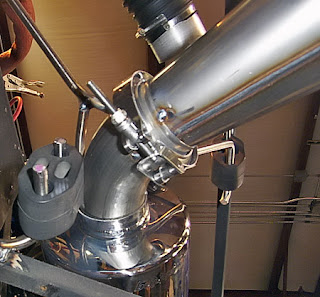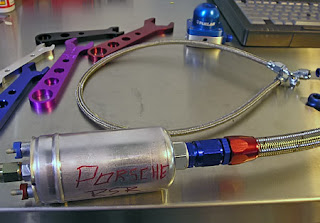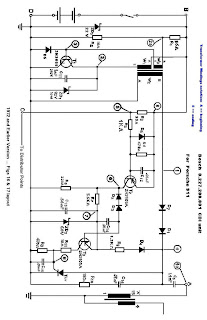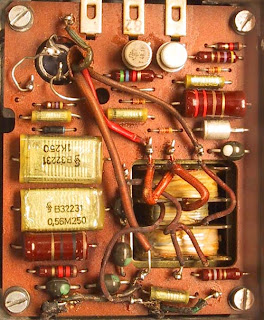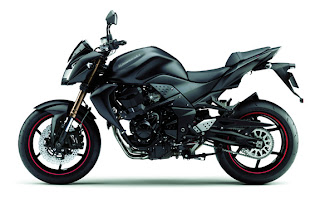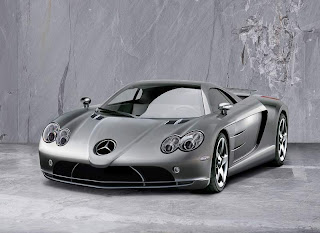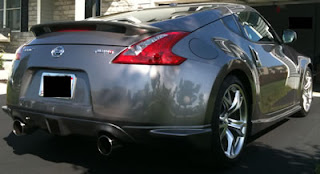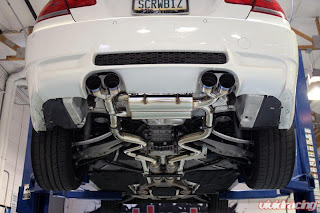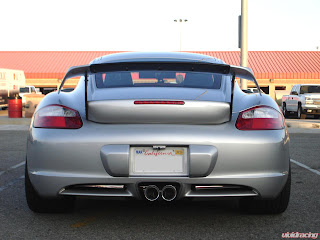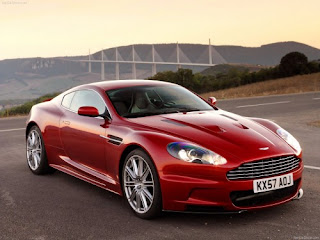Currently we only build exhaust systems on a custom basis. Complete systems include cat bypass with expansion joints, polished free flow muffler section, v-band clamps all mandrel bends, is t304 stainless throughout and features a single outlet tip only- Our setup is tig welded for durability and attractiveness and is very agressive- sound is clean inside and out. We also offer a megaphone outlet, non resonated (no muffler section)- It is VERY loud but sounds fantastic and is exceptionally free flow- has a similar sound to a 996GT3RSR at full throttle.
Fuel Pump Upgrade
Retrofitted Bosch Fuel Pump Typically Found in Porsche RSR.
For high performance only, this Bosch racing fuel pump will pump up to 172 litres per hour at 100 psi. Another must for big horsepower, high boost applications. Fits nicely in the stock location. REQUIRES custom plumbing, minimum -10 feed line, -6 pressure line and rewire fuel pump ground and separate fuel pump relay.
ZAP Alias ELECTRIC VEHICLE
ZAP Alias ELECTRIC VEHICLE
All-electric vehicles may seem like an impossible dream to most, with a price point that’s far out of reach. That may soon change, if car company ZAP gets its way. It has just announced a partnership with China Youngman Automotive Group to produce the Alias, a $30,000 electric vehicle that will be available in 2009
ZAP believes that thanks to how fast automotive technology is advancing, it can produce such vehicle by the specified time frame. Its a difficult task as they have yet to produce a full prototype of the Alias. It does have a full specification showing what it hopes the final product will be. The three-wheeled Alias will be powered by two in-wheel 320-horsepower motors, which will be capable of taking the car from 0 to 60 in about 6 seconds. It should take go for 150 miles on one charge. A hybrid range extender is also in the works.
Getting a full vehicle within two years seems difficult, however the car manufacturer is hopeful. It has just recently made an invitation to its suppliers with hopes of getting to the affordable price range that it is looking for. Having said that, if they can bring that car at that price, well, they could own the market.
Getting a full vehicle within two years seems difficult, however the car manufacturer is hopeful. It has just recently made an invitation to its suppliers with hopes of getting to the affordable price range that it is looking for. Having said that, if they can bring that car at that price, well, they could own the market.
Speed Roadster Engine
Speed Roadster Engine
Engine: 2004- 2.4 L (144 c.i. / 4 cyl) Turbo Charged Dodge SRT-4 (F class)
Transmission: 3-speed automatic
Estimated HP- 750 on gas and 950+ on fuel (alcohol)
Transmission- Automatic rear wheel drive
sleek speedracing bike concept
sleek speedracing bike concept
After one look at the Indian-branded “Speed Racer” motorcycle concept bike by Dan Bailey, it is easy to see how he incorporated the main characters in the Aliens movie franchise into the aesthetics. Using the specs on the Kawasaki Ninja as his framework, Bailey sought to design a bike that was rugged but maintained a sleek look—a mission he has certainly accomplished. I don’t know if the Speed Racer will ever go into production, but for a design with the balls to take elements from three iconic franchises (maybe four if you count TRON), the bike holds up well.
2011 Suzuki GSX-R750
Handlebars set 1 degree farther away from the rider provide greater leverage and contribute to a roomier cockpit. The gas tank still holds a maximum of 4.5 gallons, but a flatter top allows taller riders to get behind the windscreen more easily. The seat is narrower, and new footpegs are three-way adjustable for height. Instrumentation and switchgear were lifted from the GSX-R1000.
Why Brembo? Simple answer: marketing. That said, test riders liked the improved feel, and the calipers are lighter than the previous four-piston Nissins. The Japanese brake maker still supplies the master cylinder, though the radial-mount design is a different spec from the unit that was used on the last-generation GSX-R600. Nissin supplies the rear brakes for both models.
Where did the GSX-Rs lose weight? Suzuki provided the following breakdown:
Frame: 2 lb. 15 oz.
Front suspension: 1 lb. 15.3 oz.
Rear suspension: 3.1 oz.
Front wheel/axle: 9.0 oz.
Rear wheel/axle: 11.9 oz.
Front brakes: 14.5 oz.
Rear brake: 11.4 oz.
Pistons: 2.7 oz.
Transmission: 6.5 oz.
ECM: 11.6 oz.
Muffler: 3 lb. 12.0 oz.
Body: 7 lb. 7.9 oz.
Headlight: 1 lb. 3.8 oz.
Seat: 8.6 oz.
Footpegs: 1.8 oz.
Pricing? Hang on to your helmets. The GSX-R600 will retail for $11,599—a $1200 increase over the 2009 model. Just $400 more, however, will send you streaking toward the horizon on a bigger-bore, longer-stroke and nearly as light GSX-R750. Care to guess which model Suzuki expects to sell more of?
For the same price as the GSX-R600, you could opt for the GSX1250AF, which comes standard with a full fairing housing GSX-R-style vertically stacked headlights. Anti-lock brakes and a centerstand are included. To aid engine cooling, engineers added a secondary “reserve” fan that kicks on if the liquid-cooled, dohc, 16-valve inline-Four hits 110 degrees Celsius. Radiator-cap pressure is also higher. The handlebar has a slightly different, allegedly more comfortable, bend. As with the previous Bandit, there are two seat heights: 31.7 inches and 32.5. Claimed full-tank curb weight is 567 pounds. Side and top cases will be available through Suzuki’s accessory department.
Moving forward, Suzuki expects a tough haul. National sales manager Rod Lopusnak called the current economic environment “the new normal.” A full line of 2011 models, including two new GSX-Rs and a light-duty sport-tourer, is an exciting new beginning.
Suzuki GSX-R600
American Suzuki pulled the wraps off three new 2011 models—GSX-R600, GSX-R750 and GSX1250FA—this past weekend at its national dealer show in Las Vegas. Said to weigh as much as 20 pounds less than the current models, the latest GSX-Rs wear Brembo Monobloc front brake calipers and share a number of components, including Showa’s Big Piston Fork, with the current GSX-R1000. Meanwhile, the GSX1250FA is a fully faired, anti-lock-brake-equipped version of the discontinued Bandit 1250S.
Hundreds of dealers from across the country attended the event, which was hosted by motorsports personality Erin Bates. Addressing the crowd, company president Mr. Sato spiritedly voiced, “We’re still here, we’re still standing and it’s time to move forward.” Executive VP of motorcycle and marine, Mr. Tanaka, added, “Suzuki is globally diverse and financially strong.”
This past year, American Suzuki made the difficult decision to import only a small number of mostly off-road-only 2010 models. The goal was to help dealers clean up existing non-current inventory and get back on their collective feet. According to Tanaka, Suzuki now has a clear plan to market, distribute and sell both new and existing products, turning “adversity into advantage.”
In the weeks leading up to the show, Suzuki introduced 10 2011 models: Hayabusa, Boulevard M109R, Boulevard M109R Limited Edition, Boulevard S40, RM-Z450, RM-Z250, TU250, V-Strom 650 ABS, DR650SE and DR-Z400S. The GSX-R1000, Boulevard C50T, Burgman 650 Executive and Burgman 400 ABS have since been confirmed, as well.
Senior VP for economic and tax policy and chief economist at the U.S. Chamber of Commerce (and Suzuki KingQuad ATV owner) Dr. Martin Regalia delivered an informative and well-timed keynote address. “Nothing should take precedence over getting the economy growing,” he said. “At least we’re now moving in the right direction.”
Suzuki has reportedly sold 300,000 GSX-Rs in the U.S. since the first 750 model was introduced to these shores in 1986. About the new 600, Suzuki field service manager Derek Schoeberle said, “It may look like the GSX-R of old, but it’s completely different. We’ve made leaps, here—major, major changes.”
According to Schoeberle, Suzuki had three goals for the GSX-R600 and 750: 1) enhanced racetrack performance; 2) new styling; and 3) weight reduction. Aside from their engines and transmissions, the two models are identical.
More compact looks and fitment of the aforementioned 43mm Showa Big Piston Fork and Brembo front brake calipers are the biggest visual clues that these are new models. Behind the fairing with its vertically stacked headlights, a five-piece frame houses an uprated engine with lighter pistons and connecting rods, titanium valves (new to the 750), altered camshaft profiles, more steeply angled primary fuel injectors and updated crankcase ventilation for reduced pumping losses. The handlebar-mounted S-DMS (Suzuki Drive Mode Selector) now has just two engine settings—A (full power) and B (wet conditions). The GSX-R600 has lighter transmission gears and closer ratios for first through fourth. Additionally, sixth is lower.
By rotating the engine backward 3 degrees, engineers were able to bring the pivot point for the new gravity-cast swingarm closer to the front axle and shorten the wheelbase to 54.5 inches, a 15mm reduction. Because swingarm length remains the same, there’s additional weight over the front wheel. Rake is 23.8 degrees. Of the current Japanese middleweights, only the Honda CBR600RR has a steeper steering-head angle. Trail is 3.8 inches, identical to the Honda. Improved low- and high-speed stability are claimed.
Hundreds of dealers from across the country attended the event, which was hosted by motorsports personality Erin Bates. Addressing the crowd, company president Mr. Sato spiritedly voiced, “We’re still here, we’re still standing and it’s time to move forward.” Executive VP of motorcycle and marine, Mr. Tanaka, added, “Suzuki is globally diverse and financially strong.”
This past year, American Suzuki made the difficult decision to import only a small number of mostly off-road-only 2010 models. The goal was to help dealers clean up existing non-current inventory and get back on their collective feet. According to Tanaka, Suzuki now has a clear plan to market, distribute and sell both new and existing products, turning “adversity into advantage.”
In the weeks leading up to the show, Suzuki introduced 10 2011 models: Hayabusa, Boulevard M109R, Boulevard M109R Limited Edition, Boulevard S40, RM-Z450, RM-Z250, TU250, V-Strom 650 ABS, DR650SE and DR-Z400S. The GSX-R1000, Boulevard C50T, Burgman 650 Executive and Burgman 400 ABS have since been confirmed, as well.
Senior VP for economic and tax policy and chief economist at the U.S. Chamber of Commerce (and Suzuki KingQuad ATV owner) Dr. Martin Regalia delivered an informative and well-timed keynote address. “Nothing should take precedence over getting the economy growing,” he said. “At least we’re now moving in the right direction.”
Suzuki has reportedly sold 300,000 GSX-Rs in the U.S. since the first 750 model was introduced to these shores in 1986. About the new 600, Suzuki field service manager Derek Schoeberle said, “It may look like the GSX-R of old, but it’s completely different. We’ve made leaps, here—major, major changes.”
According to Schoeberle, Suzuki had three goals for the GSX-R600 and 750: 1) enhanced racetrack performance; 2) new styling; and 3) weight reduction. Aside from their engines and transmissions, the two models are identical.
More compact looks and fitment of the aforementioned 43mm Showa Big Piston Fork and Brembo front brake calipers are the biggest visual clues that these are new models. Behind the fairing with its vertically stacked headlights, a five-piece frame houses an uprated engine with lighter pistons and connecting rods, titanium valves (new to the 750), altered camshaft profiles, more steeply angled primary fuel injectors and updated crankcase ventilation for reduced pumping losses. The handlebar-mounted S-DMS (Suzuki Drive Mode Selector) now has just two engine settings—A (full power) and B (wet conditions). The GSX-R600 has lighter transmission gears and closer ratios for first through fourth. Additionally, sixth is lower.
By rotating the engine backward 3 degrees, engineers were able to bring the pivot point for the new gravity-cast swingarm closer to the front axle and shorten the wheelbase to 54.5 inches, a 15mm reduction. Because swingarm length remains the same, there’s additional weight over the front wheel. Rake is 23.8 degrees. Of the current Japanese middleweights, only the Honda CBR600RR has a steeper steering-head angle. Trail is 3.8 inches, identical to the Honda. Improved low- and high-speed stability are claimed.
Kawasaki Z750R
Kawasaki's Z750 has been one of Europe's most successful naked middleweights. The three-quarter-liter inline-Four is a good all-around performer, efficient and versatile, nicely styled and finished. Last year, however, sales dipped sharply, due in part to the worldwide economic crisis and changes in market tastes.
In response, Kawasaki's European branch urged management in Japan to take appropriate action to hold its position in this critical segment. Their response is the 2011 Z750R.
This "R" is a natural evolution of the Z750, which remains for sale as an entry-level model. This version was developed as a private owner would have done it himself, adding state-of-the-art components that didn't require major reworking or machining but would result in a higher level of performance while dramatically altering the bike's appearance.
2011 Kawasaki Z250R brakes
Beefy brakes: 2011 Kawasaki Z750R is equipped with four-piston radial-mount brakes and 300mm rotors. ABS is optional.
The engine remains the same reliable and tractable, liquid-cooled, dohc, 16-valve, 748cc Four fed by 32mm Keihin throttle bodies. Power claims are 106 hp at 10,500 rpm with 57.8 ft.-lb. peak torque at 8300 rpm.
That engine is harnessed by the Z750 chassis, unchanged in geometry or structure, but with better brakes, suspension and rolling gear. The inverted 41mm fork, inherited from the 2009 Z1000, is adjustable for spring preload and rebound damping. The swingarm is new, fabricated from cast and stamped aluminum elements and actuating a piggyback-style shock, which is also adjustable for preload and rebound.
The entire braking system has been upgraded. Up front, 300mm rotors are teamed with four-piston radial-mount calipers. The rear rotor is sized down to 250mm and the caliper is a floating single-piston unit. All rotors are thicker, up from 4.5mm to 6.0, and have a daisy-style design. Brake lines are steel-braided, and ABS is available.
Styling is sharper, with a new bikini fairing and updated instrumentation. The front fender and the massive, Z1000-like muffler are also new. Options include an Akrapovic exhaust, a suede-trimmed sport seat, a spoiler and imitation carbon-fiber add-ons. Two-tone or matte-black paint schemes contribute to the edgy new look, making the Z750R a very desirable naked bike.
In response, Kawasaki's European branch urged management in Japan to take appropriate action to hold its position in this critical segment. Their response is the 2011 Z750R.
This "R" is a natural evolution of the Z750, which remains for sale as an entry-level model. This version was developed as a private owner would have done it himself, adding state-of-the-art components that didn't require major reworking or machining but would result in a higher level of performance while dramatically altering the bike's appearance.
2011 Kawasaki Z250R brakes
Beefy brakes: 2011 Kawasaki Z750R is equipped with four-piston radial-mount brakes and 300mm rotors. ABS is optional.
The engine remains the same reliable and tractable, liquid-cooled, dohc, 16-valve, 748cc Four fed by 32mm Keihin throttle bodies. Power claims are 106 hp at 10,500 rpm with 57.8 ft.-lb. peak torque at 8300 rpm.
That engine is harnessed by the Z750 chassis, unchanged in geometry or structure, but with better brakes, suspension and rolling gear. The inverted 41mm fork, inherited from the 2009 Z1000, is adjustable for spring preload and rebound damping. The swingarm is new, fabricated from cast and stamped aluminum elements and actuating a piggyback-style shock, which is also adjustable for preload and rebound.
The entire braking system has been upgraded. Up front, 300mm rotors are teamed with four-piston radial-mount calipers. The rear rotor is sized down to 250mm and the caliper is a floating single-piston unit. All rotors are thicker, up from 4.5mm to 6.0, and have a daisy-style design. Brake lines are steel-braided, and ABS is available.
Styling is sharper, with a new bikini fairing and updated instrumentation. The front fender and the massive, Z1000-like muffler are also new. Options include an Akrapovic exhaust, a suede-trimmed sport seat, a spoiler and imitation carbon-fiber add-ons. Two-tone or matte-black paint schemes contribute to the edgy new look, making the Z750R a very desirable naked bike.
Beefy brakes: 2011 Kawasaki Z750R is equipped with four-piston radial-mount brakes and 300mm rotors. ABS is optional.
Triumph Bonneville
Years sold: 10 (2001-present)
MSRP new: $6699 (2001) to $8899 (2010)
Blue Book retail value: $3235 (2001) to $7590 (2010)
Basic specs: A standard-style parallel-Twin in either 790cc or 865cc displacements making horse power in the fifties, torque in the forties and posting quarter-mile times in the high- to mid-13-second bracket.
Why it won: Though this modern reincarnation of the legendary Bonneville has sold well and won countless diehard fans around the world, it has never managed to win a CW Ten Best Award. It seemed to be star-crossed in that regard, because any time it was a contender, it always got edged out by some other bike in its category that had just a little more of something special going for it. But that does not diminish the character or excellence of these machines, which combine the experience of riding a timeless classic with the quality and reliability of modern technology.
The first “new” Bonneville was a 790cc carbureted model that arrived in 2001 as the sole Twin in the company’s lineup. The model spread to three variations in 2002, four in ’03 and five in ’04, including one, the Speedmaster, having its displacement bumped up to 865cc. In 2007, all six of the parallel-Twin models got the larger engine, and by 2008, the line had expanded to eight fuel-injected models. No, they all are not called Bonneville, but they are close variations based on the same engine and basic chassis design.
Useful resources: If you type “Triumph Bonneville” into your browser’s search engine, you’ll come up with about a gazillion entries—clubs, forums, road tests, parts and accessories, for-sale classifieds, hop-up equipment, you name it. Many of those sites are devoted to the original Bonneville, of course, but you’ll likely find just about anything imaginable on-line related to the new-gen Bonnies.
Triumph Thunderbird 1600
For Triumph, building a great parallel-Twin was no big deal, even though this counterbalanced 1596cc unit is the biggest one it's ever built. The T-Bird's pair of 4-inch pistons make more torque at 2630 rpm—95.1 ft.-lb.—than most cruiser motors make all day. But this bike's more than a pair of big jugs. It rumbles along smoothly, soulfully, while providing comfortably kicked-back ergonomics and suspension that actually suspends. Triumph being Triumph, it couldn't even keep from building a big cruiser that handles okay, too, and then wrapped it up in crisp styling, with a shapely no-seams gas tank, maximum chrome and minimal plastic. The result is a repeat winner as CW's Best Cruiser.
Maserati BORA
Maserati BORA
SPECIFICATIONS
engine – V8valvetrain – DOHC 2 Valves / Cyl
displacement – 4930 cc / 300.8 cu in
bore – 93.9 mm / 3.7 in
stroke – 89 mm / 3.5 in
compression – 8.7:1
power – 246.1 kw / 330.0 bhp @ 5500 rpm
hp per litre – 66.94 bhp per litre
bhp/weight
torque – 481.32 nm / 355.0 ft lbs @ 4500 rpm
front brakes – Vented Discs
front wheels F – 38.1 x 19.0 cm / 15.0 x 7.5 in
rear wheels R – 38.1 x 19.0 cm / 15.0 x 7.5 in
front tire size – 205/70VR15
rear tire size – 215/70VR15
weight – 1610 kg / 3549 lbs
wheelbase – 2600 mm / 102.4 in
front track – 1474 mm / 58.0 in
rear track – 1447 mm / 57.0 in
length – 4335 mm / 170.7 in
width – 1768 mm / 69.6 in
height – 1134 mm / 44.6 in
transmission – 5-Speed Manual
Masda RX-7
Masda RX-7
The third and final iteration of the highly popular RX-7 hit the streets of Japan in 1992, and America a year later. Power was generated by the first-ever mass-produced sequential twin-turbocharger system to export from Japan, an extremely complex piece of machinery that gave the RX-7 a wide and usable torque curve throughout the entire RPM range. Car and Driver voted it to their 10 Best list ’93-95, and Playboy awarded the RX-7 victor in a head-to-head contest against the Dodge Viper. Handling was world class, and to this day remains one of the finest handling cars of all time thanks in part to its front-mid-engine layout, and its futuristic looks have kept the car looking sexy after all these years.
Aston Martin DBS V12
Aston Martin DBS V12
No doubt any car lover who saw Casino Royale will have the image of this car bursting into worthless scrap tattooed to the inside of their eye lids. Yet, this isn’t the first time (nor will it be the last time on our list) that a Bond movie puts an Aston in the spot light. The DBS replaced the outgoing Vanquish as the top of the line model in Aston’s lineup, and also garnered the title of the fastest car ever produced by those Britishmen. Essentially a leaned down version of the DB9 with more power and no back seats, the DBS can run with all but the very best of them, while retaining an immaculate interior and a painfully pretty exterior–which are the hallmarks of every Aston Martin.
Ferrari 599 GTB Fiorano
Ferrari 599 GTB Fiorano
The 599 is a Grand Touring car from Ferrari that combines svelte looks with superb handling AND outrageous performance in a way none of the previous cars on the list could do. It is also the most powerful street car Ferrari has ever produced, with 612 HP at the flywheel, and features an “F1 Superfast” sequential manual gearbox that changes gears faster than most of us can blink. And while the 599 will no doubt prove to be another classic from Maranello, the car’s technological innovations, at least at this point, make its spec sheet more praiseworthy than the car itself.
Gumpert Apollo
Gumpert Apollo
This could easily have been called the Gumpert Phlair because its go-fast aesthetics are just that redundant, and in this the Apollo is the exact opposite of the 8C: It is form following function, and at times, following very very far behind indeed. Intended to be a street-legal but track-ready sports car, every inch of the Apollo’s bulbous surface is made for generating downforce or sheeting the air over and under the car as efficiently as possible, enabling the car to allegedly drive upside down when traveling over 190 mph. I say “allegedly” because, surprisingly, no one has been willing to lay their life on the line just to so Gumpert can list another selling feature in their Apollo brochure.
Alfa Romeo 8C Competizione
Alfa Romeo 8C Competizione
Any petrol head learns that the true beauty of an Alfa is in the intangibles–things besides dependability, build quality, handling, and performance. In terms of performance the 8C is an exception. Making use of a Maserati-sourced V8, the 8C rockets to 60 in 4.2 seconds, and even pulls 1.02G around the skid pad. But the driving dynamics are all off. The steering is numb, there is tremendous oversteer, and the paddle-shifter gear box is quite possible one of the worst ever constructed. But, as Oscar Wilde said, “All art is quite useless,” and it is for this very reason that the 8C ascends to the status of moving art–more so than even Ferrari–as it is undoubtedly one of the beautiful cars ever constructed.
NOBLE M15
NOBLE M15
The M12 was a great car in its own right, but it was still just another thinly disguised race car in street trim. And Lee Noble knew it. So when he created the M15, it was with the intention of creating a genuine competitor to Italian and German exotics twice its price by including luxury amenities such as Sat Nav and providing ample storage space for all those groceries every moderately wealthy gear head needs–and needs fast. But despite all the fluff, the M15 is still one of the purest driving cars ever built, powered by a 455bhp 3.0L twin turbo that’s tuned for acceleration–not top speed–to the “tune” of some 3.5 seconds to 60 mph.
Subscribe to:
Comments (Atom)
